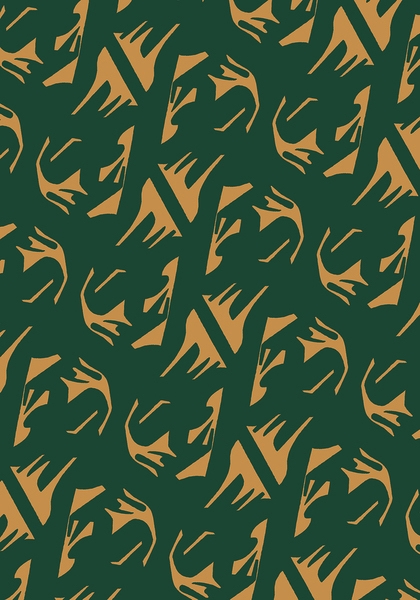By Pak Sheung Chuen, Para Site, HK$360 (hardcover)
Reviewed by Adeline Chia
During the Umbrella Movement in 2014, when Hongkongers took to the streets demanding more transparent elections, Pak Sheung Chuen, who made a career out of gently interventionist conceptual gestures, felt his art was out of touch with political reality. So he joined protesters in the occupation of the city centre. But the movement fizzled out, there was no electoral reform and prominent instigators were eventually arrested and charged. Pak fell into depression.
As part of his recovery, he started attending the court hearings of people involved in the Umbrella Movement. There, he took notes, and in a meditative state, made automatic drawings. Some he simplifies into ideograms he calls ‘seals’, which look a bit like logos of secret orders. Others he tessellates into patterns he calls ‘nightmare wallpapers’. All of them are subject to long written analyses by him. These Rorschach-like shapes, in which Pak sees human figures and objects, as well as specific imagery like angels, were drawn during the last five years and are now collected in Nightmare Wallpaper. In this hard-to-categorise publication, Pak uses art and writing to process his feelings of failure and disillusionment. Featured are some court reports he wrote for his column in the Sunday edition of Chinese-language newspaper Ming Pao, and some documentation of performances he did, such as his annual ceremony of burning a picture of the fire seen in Tiananmen Square. There’s also a series of poetic letters exchanged with a protester in jail. And of course the notebook scans and the automatic drawings done while attending court hearings.
Editor Freya Chou says the book is meant to be consoling, especially for Hongkongers facing a political impasse described by the government as the ‘worst crisis in Hong Kong since the Handover’. At the time of writing, clashes between pro-democracy and pro-Beijing camps have not abated, with the coronavirus epidemic stoking more anti-mainlander sentiment. Is this book, then, as Chou suggests, ‘a proposition on how to release the internalised trauma and melancholia from the recent political instability; how to reconcile with violence, conflicts, and most importantly, with oneself’?
It certainly has a reflective quality, and doesn’t agitate for direct political action. Instead it is more concerned with internal transformation – most clearly seen in the seal and wallpaper works, which relinquish conscious control and embrace the irrational.
On the one hand, I am open to the idea that these automatic drawings may loosen up the stagnated conversation around politics, by throwing up symbols so esoteric that they cannot be instrumentalised. After all, research shows that when it comes to political opinion, a lot of our cognitive and emotional reactions are triggered subconsciously. On the other hand, I’m not really sure what these psychic excavations or Pak’s lengthy interpretations bring to the table. It’s a bit like telling people about last night’s dreams: they are fascinating only to the dreamer himself.
If the book has a rehabilitative effect, it is found more obviously in the direct interventions Pak makes into the lives of others. With an inmate called Z, he exchanges letters on music, art and their shared Christianity. Their correspondence is the most affecting section of the book. Z reflects on how much the Umbrella Movement has cost him. In one missive, he describes the view from his cell, with the moon over the water and the lights from the fishing boats, a scene he shared with his wife in a letter, ‘letting her know that we are living under the same sky’. A few letters later, his wife leaves him. He says his impending release feels ‘like going from a small cell to a bigger one’. Politics often relies on binaries – us versus them, victory and defeat – but there are human experiences that are beyond such categorisation. At its best, Nightmare Wallpaper gestures towards that truth.
From the Spring 2020 issue of ArtReview Asia
